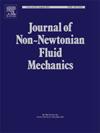Suppression and augmentation in vortex shedding frequency due to fluid elasticity
IF 2.7
2区 工程技术
Q2 MECHANICS
引用次数: 0
Abstract
Several previous experimental and numerical studies have demonstrated the suppression of vortex shedding frequency from bluff bodies, such as circular cylinders, due to fluid elasticity induced by adding solid polymer additives to a solvent like water, even in parts per million (ppm) quantities. However, this study reveals a more complex relationship between the two using extensive two-dimensional (2D) direct numerical simulations (DNS) of flows past a circular cylinder at a fixed Reynolds number of 100. Our findings show that the vortex shedding frequency initially decreases with increasing Weissenberg number (a measure of fluid elasticity), reaches a minimum at a critical Weissenberg number, and then increases with further increments in the Weissenberg number. The same non-monotonic trend is also observed in the temporal variation of the spanwise velocity component fluctuation within the flow domain. This study aims to elucidate the reasons behind these non-monotonic trends in vortex shedding frequency and velocity component fluctuations as functions of the Weissenberg number. Our detailed analysis attributes these trends to significant alterations in the vortex-shedding mechanism as fluid elasticity increases due to the appearance of inertio-elastic instability at higher Weissenberg numbers. Our findings also align with limited experimental observations of similar unexpected behaviors in viscoelastic fluids, providing new insights into the underlying mechanisms. Moreover, the study highlights that shear-thinning behavior in viscoelastic fluids counteracts these non-monotonic trends, instead promoting a monotonic increase in vortex shedding frequency with the Weissenberg number. Finally, the 2D simulation results show both qualitative and quantitative agreement with limited three-dimensional (3D) simulations conducted at higher Weissenberg numbers where the flow may transit from 2D to 3D due to the appearance of inertio-elastic instability.
流体弹性对旋涡脱落频率的抑制和增强
之前的一些实验和数值研究已经证明,即使在百万分之一(ppm)的溶剂中添加固体聚合物添加剂,也会引起流体弹性,从而抑制钝体(如圆柱体)的涡流脱落频率。然而,这项研究通过广泛的二维(2D)直接数值模拟(DNS)揭示了两者之间更复杂的关系,这些模拟是在固定雷诺数为100的情况下流过圆柱体的。我们的研究结果表明,旋涡脱落频率最初随着Weissenberg数(流体弹性的度量)的增加而降低,在临界Weissenberg数达到最小值,然后随着Weissenberg数的进一步增加而增加。流域中沿展向速度分量波动的时间变化也表现出同样的非单调趋势。本研究旨在阐明涡旋脱落频率和速度分量波动作为Weissenberg数函数的非单调趋势背后的原因。我们的详细分析将这些趋势归因于涡流脱落机制的重大变化,因为在较高的Weissenberg数下,由于惯性-弹性不稳定性的出现,流体弹性增加。我们的发现也与粘弹性流体中类似意外行为的有限实验观察相一致,为潜在机制提供了新的见解。此外,研究强调粘弹性流体中的剪切变薄行为抵消了这些非单调趋势,而是促进了涡脱落频率随Weissenberg数的单调增加。最后,二维模拟结果在定性和定量上与较高Weissenberg数下进行的有限三维(3D)模拟结果一致,在较高的Weissenberg数下,由于惯性-弹性不稳定性的出现,流动可能从二维过渡到三维。
本文章由计算机程序翻译,如有差异,请以英文原文为准。
求助全文
约1分钟内获得全文
求助全文
来源期刊
CiteScore
5.00
自引率
19.40%
发文量
109
审稿时长
61 days
期刊介绍:
The Journal of Non-Newtonian Fluid Mechanics publishes research on flowing soft matter systems. Submissions in all areas of flowing complex fluids are welcomed, including polymer melts and solutions, suspensions, colloids, surfactant solutions, biological fluids, gels, liquid crystals and granular materials. Flow problems relevant to microfluidics, lab-on-a-chip, nanofluidics, biological flows, geophysical flows, industrial processes and other applications are of interest.
Subjects considered suitable for the journal include the following (not necessarily in order of importance):
Theoretical, computational and experimental studies of naturally or technologically relevant flow problems where the non-Newtonian nature of the fluid is important in determining the character of the flow. We seek in particular studies that lend mechanistic insight into flow behavior in complex fluids or highlight flow phenomena unique to complex fluids. Examples include
Instabilities, unsteady and turbulent or chaotic flow characteristics in non-Newtonian fluids,
Multiphase flows involving complex fluids,
Problems involving transport phenomena such as heat and mass transfer and mixing, to the extent that the non-Newtonian flow behavior is central to the transport phenomena,
Novel flow situations that suggest the need for further theoretical study,
Practical situations of flow that are in need of systematic theoretical and experimental research. Such issues and developments commonly arise, for example, in the polymer processing, petroleum, pharmaceutical, biomedical and consumer product industries.

 求助内容:
求助内容: 应助结果提醒方式:
应助结果提醒方式:


